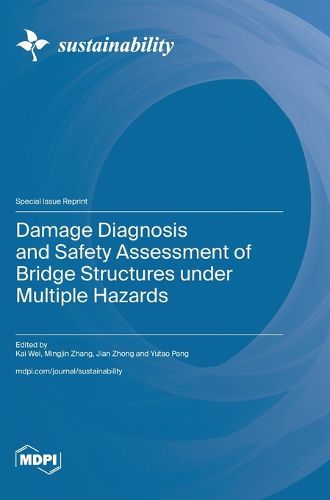Readings Newsletter
Become a Readings Member to make your shopping experience even easier.
Sign in or sign up for free!
You’re not far away from qualifying for FREE standard shipping within Australia
You’ve qualified for FREE standard shipping within Australia
The cart is loading…






This title is printed to order. This book may have been self-published. If so, we cannot guarantee the quality of the content. In the main most books will have gone through the editing process however some may not. We therefore suggest that you be aware of this before ordering this book. If in doubt check either the author or publisher’s details as we are unable to accept any returns unless they are faulty. Please contact us if you have any questions.
The states of bridge structures decline over time due to various degradation processes, such as creep, corrosion, and cyclic loading. During its life cycle, a bridge also faces the great threat of multiple hazards, such as winds, earthquakes, collisions, waves, landslides, and so on. Structural damages in an existing bridge affect operational and structural safety and weaken the sustainability of bridges. Therefore, advanced damage diagnosis techniques and safety assessment methods are strongly required to ensure structural safety and achieve infrastructure sustainability. This Special Issue aims to bring together recent scientific developments in probabilistic hazard analysis, structural exposure models, damage diagnosis methods, testing and measurement techniques, dynamic behavior and protection technology, damage mechanisms, risk assessment framework, and resilience-based approaches. Since we have past one year since this Special Issue opened, thirteen papers have been published, the majority of which focus on the structural safety assessment of bridges under wind, earthquake, collision, wave, etc. The Guest Editors believe that this reprint will provide important theoretical and technical support for bridge damage diagnosis and safety assessment and promote communication and cooperation between design, construction, research, teaching, and production.
$9.00 standard shipping within Australia
FREE standard shipping within Australia for orders over $100.00
Express & International shipping calculated at checkout
This title is printed to order. This book may have been self-published. If so, we cannot guarantee the quality of the content. In the main most books will have gone through the editing process however some may not. We therefore suggest that you be aware of this before ordering this book. If in doubt check either the author or publisher’s details as we are unable to accept any returns unless they are faulty. Please contact us if you have any questions.
The states of bridge structures decline over time due to various degradation processes, such as creep, corrosion, and cyclic loading. During its life cycle, a bridge also faces the great threat of multiple hazards, such as winds, earthquakes, collisions, waves, landslides, and so on. Structural damages in an existing bridge affect operational and structural safety and weaken the sustainability of bridges. Therefore, advanced damage diagnosis techniques and safety assessment methods are strongly required to ensure structural safety and achieve infrastructure sustainability. This Special Issue aims to bring together recent scientific developments in probabilistic hazard analysis, structural exposure models, damage diagnosis methods, testing and measurement techniques, dynamic behavior and protection technology, damage mechanisms, risk assessment framework, and resilience-based approaches. Since we have past one year since this Special Issue opened, thirteen papers have been published, the majority of which focus on the structural safety assessment of bridges under wind, earthquake, collision, wave, etc. The Guest Editors believe that this reprint will provide important theoretical and technical support for bridge damage diagnosis and safety assessment and promote communication and cooperation between design, construction, research, teaching, and production.